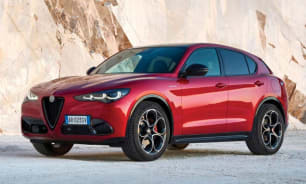Engage the standard launch control function, step through the blast-off procedure and Maserati says you'll rocket from 0-100km/h in 3.8 seconds, which is supercar fast.
And the way this twin-turbo V6 delivers that kind of performance is impressive; beautifully linear without a hint of lag.
Trundle along at 60km/h, pin the throttle and you'll be in 'lock 'em up and throw away the key' territory in the blink of an eye. This is a full-blown rocket sled.
All 620Nm of peak torque is available from 3000-5500rpm with maximum power (390kW) arriving at 6500rpm. No matter which drive mode you've selected (more on that shortly), thunderous performance is only an extension of your right ankle away.
And the aural accompaniment walks a perfect line between potency and civility, the signature Maserati exhaust growl stepping up a notch in the racier settings but rarely crossing over into bellicose 'boy racer' territory. We have no problem with an occasional pop and bang on the overrun!
At a touch over two tonnes, the Grecale Trofeo is far from a featherweight, but when you're racing up and down the quick-shifting auto transmission's eight ratios, it feels like one.
The elegant alloy, column- (not wheel-) mounted 'manual' shift levers add to the fun and there are five drive modes to play with - 'Comfort', 'GT', 'Sport', 'Corsa' and 'Off-road' - adapting the engine, transmission, steering and suspension.
The track-focused Corsa set-up starts to soften off some of the traction and stability controls, so we didn't go there, but can confirm off-road raises ride height by 30mm (FYI, we didn't head off-road, either).
Suspension is by double wishbones at the front and multi-links at the rear supported by active dampers and air 'springs' all around.
In the softer Comfort setting, ride compliance is on the firm side. Never harsh, but a little more communicative in terms of bumps and thumps than you might expect.
Not for the first time I found the best arrangement was Sport, dialling everything up to racier settings, and the suspension in 'Comfort' which can be achieved with the press of a wheel-mounted button.
The electrically-assisted rack and pinion steering is accurate and quick to respond with excellent road feel thrown in for good measure.
Just beware the flip side of this type of 'quick' steering rack is invariably a large turning circle, and the Grecale Trofeo is no exception.
The staggered 21-inch rims are shod with high-performance Bridgestone Potenza Sport rubber (225/40 fr / 295/35 rr) and the AWD system, complete with rear LSD, help the car feel securely planted and balanced in quick cornering.
Braking is professional grade with big ventilated and cross-drilled rotors front and rear with fixed Brembo calipers at both ends - six piston front and four-piston rear.
Maserati claims the Grecale Trofeo will slow from 100km/h to a standstill in less than 40m, which is not a lot of metres from that speed.
I had one telling 'will I, or won't I?' situation when presented with an amber light and in deciding to give the brakes a workout (there was no one behind me) was rewarded with a secure and insanely rapid stop.
In terms of general observations, the placement of the start button and drive-mode dial on the steering wheel is a nice touch, the front seats are superb in terms of support and comfort, the media interface is quick and easy to use and the only strong hint of Maserati's Stellantis ownership came in the form of familiar 'Jeep-style' audio control rocker switches on the back of the steering wheel.

